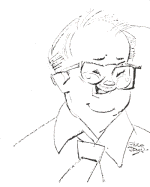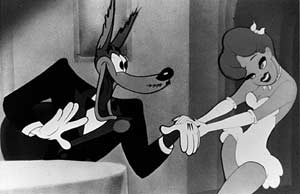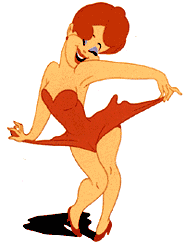|
Situations Still Being Imitated

Frederick Bean "Tex" Avery was an animator, cartoonist, and director, famous for producing animated cartoons during
the Golden Age of Hollywood. He did his most significant work for the famed Warner Bros. in the area of the studios that was known as (Termite Terrace) and Metro-Goldwyn-Mayer studios, creating the characters of Bugs Bunny, Daffy Duck, and Droopy; and his influence was found
in almost all of the animated cartoon series by various studios in the 1940s and 1950s.
Avery's style of directing broke the mold of ultra-realism established by Walt Disney, and encouraged animators to stretch the boundaries
of the medium to do things in a cartoon that could not be done in the world of live-action film. An often-quoted line from
Avery's cartoons was, "In a cartoon you can do anything," and his cartoons often did just that.
Avery first began his animation career at the Walter Lantz studios in the early 1930s, working on Oswald the Lucky Rabbit cartoons. During some office horseplay, a paperclip
flew into Avery's left eye and caused him to lose use of that eye. Some speculate it was his lack of depth perception that
gave him his unique look at animation and bizarre directorial style. (A popular catchphrase at his high school was "What's up, doc?", which he would later popularize with Bugs Bunny in the
1940s).
"Termite Terrace"
He went to the Leon Schlesinger/ Warner Bros. studio in late 1935, fast-talking Schlesinger into letting him head his own production unit of animators
and create cartoons the way he wanted them to be made. Schlesinger responded by assigning the Avery unit, including animators
Bob Clampett and Chuck Jones, to a five-room bungalow at the Warner Bros. Sunset Blvd. backlot. The Avery unit, assigned to work primarily on the black-and-white
Looney Tunes instead of the technicolor Merrie Melodies, soon dubbed their quarters "Termite Terrace", due to its significant termite population.
"Termite Terrace" later became the nickname for the entire Schlesinger/Warners studio, primarily because Avery and his
unit were the ones who defined what became known as "the Warner Bros. cartoon". Their first short, Golddiggers of '49 (1936), is recognized as the first cartoon to make Porky Pig a star, and Avery’s experimentation with the medium continued from there.
Avery, with the assistance of Clampett, Jones, and new associate director Frank Tashlin, laid the foundation for a style of animation that dethroned The Walt Disney Studio as the kings of animated short films,
and created a legion of cartoon stars whose names still shine around the world today. Avery in particular was deeply involved;
a perfectionist, Avery constantly crafted gags for the shorts, periodically provided voices for them (including his trademark
belly laugh), and held such control over the timing of the shorts that he would splice frames out of the final negative if
he felt a gag's timing wasn't quite right.
Avery At MGM
By 1942, Avery was in the employ of Metro-Goldwyn-Mayer, working in their cartoon division under the supervision of Fred Quimby. Avery felt that Schlesinger had stifled him; at MGM, Avery's creativity reached its peak. His cartoons became known for
their sheer lunacy, breakneck pace, and a penchant playing with the medium of animation and film in general that few other
directors dared to approach. MGM also offered larger budgets and a higher quality level than the Warners films. These changes
were evident in Avery's first MGM short, the Adolf Hitler-parodying The Blitz Wolf, which was nominated for the Academy Award for Best Short Subject (Cartoons) in 1942. Avery's most famous MGM character
debuted in 1943's Dumbhounded. Droopy Dog (originally "Happy Hound") was a calm, little, slow-moving and slow-talking dog who still won out in the end. He also created
a series of racy and risqué cartoons, beginning with 1943's Red Hot Riding Hood, featuring a sexy female star who never had a set name, but who influenced the minds of young boys--and future animators--worldwide.
Other Avery characters at MGM included Screwball "Screwy" Squirrel and the Of Mice and Men-inspired duo of George and Junior.
And Afterwards
Avery's return to the Walter Lantz studio did not last long. He directed four cartoons in 1954-1955: the one-shots Crazy
Mixed-Up Pup and Shh-h-h-h-h, and I'm Cold and The Legend of Rockabye Point, in which he defined
the character of Chilly Willy the penguin. Although The Legend of Rockabye Point and Crazy Mixed-up Pup were nominated for Academy Awards,
Avery left Lantz over a salary dispute, effectively ending his career in theatrical animation.
He turned to animated television commercials, most notably the Raid commercials of the 1960s , :
"Oh no! RAID! BOOM!". Avery also produced ads for fruit drinks starring the Warners Bros. characters he'd once helped
create during his Termite Terrace days.
During the 1960s and 1970s, Avery became steadily reserved and depressed, although he continued to draw respect from his
peers. His final employer was Hanna-Barbera Productions, where he wrote gags for Saturday morning cartoons such as the Droopy-esque Kwicky Koala. On August 26, 1980, he passed away on the job at the Hanna-Barbera studios.
Although he was no longer alive to experience the late-1980s renaissance of animation, his work was rediscovered and he
began to receive widespread attention and praise by the modern animation and film communities. His influence is strongly reflected
in modern cartoons such as Tiny Toon Adventures, Animaniacs, Freakazoid, The Simpsons, Family
Guy, and the Genie character in Disney's Aladdin. Today, he is seen as one of the most influential animation directors
of all time, whose mark on the industry was surpassed only by Walt Disney.

Sources of Reference
Oxford University Press. ISBN 019-516729-5.
Morris, Gary (Sept 1998).
Bright Lights Film Journal.
|
 |
|

a really great fan-based
website and the nearest
we'll get to an official one
a very comprehensive website
translated from the French by
the website's creator
This lot, saved by Avery
himself, contains many
rare original titles lost
due to Warner Brothers/
Blue Ribbon reissuing
a small collection of stills
from various animated shorts
![Droopy [click for full size image]](sitebuildercontent/sitebuilderpictures/.pond/droopy.jpg.w180h135.jpg)
|
 |
|
|
 |
|
|
|

